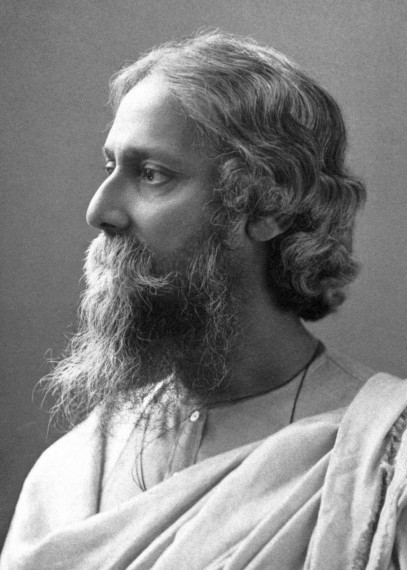
রবীন্দ্রনাথ ঠাকুর (Part-4)

The way of life at Santiniketan Brahmacharyasram was guided by the ideals of ancient Indian Tapovana. A simple carefree life in close companionship of guru-disciple. Rabindranath's main help in running this Brahmacharyasram was Brahmabandhav Upadhyaya - a Roman Catholic Vedantic monk. It was Brahmabandhav who first gave Rabindranath the title of 'World Poet'. The poet's displeasure with the conventional educational system dates back to his childhood. Therefore, the idea of a life-oriented ideal education system that existed in his mind for a long time, he made it a reality by establishing Santiniketan School. He wanted to make this school an ideal school. Rabindranath wanted to express India's hospitality to the world, India's practice, India's interest in world culture, India's devotion and love of humanity through the next phase of Visva Bharati. Santiniketan Vidyalaya was established at the beginning of the Swadeshi era and became Visva Bharati at the end of the First World War with the determination of Visva Maitri.
Rabindranath repeatedly faced various disasters in his personal and family life. Poet wife Mrinalini Devi died in 1902. Within a few months, daughter Renuka died. Maharshi Devendranath passed away in 1905 and Shamindranath, the youngest son of the poet, died in 1907. Rabindranath was overwhelmed by the grief of so many deaths, but he calmly performed the duties of the ashram. With the family disaster at that time, the poet was in extreme financial crisis. But he had a great power to overcome all crises. Therefore, his work did not get interrupted, literary pursuits did not stop.
The impact of Santiniketan episode on the literary life of Rabindranath Tagore is particularly significant. Naivedya Kavya and various essays written during this period reveal the forms of meditation and penance of ancient India. On the one hand, he portrayed the reality of life, psychology, and on the other hand, the problems of the homeland in the novels Ekshin Bali (1309), Naokadubi (1313) and Gora (1316). However, in this episode, Rabindramanas takes a great turn. It is here that the poet discovers the eternal India beyond caste narrowness. His famous composed at this time
On the one hand, the national nature of India and the course of its history became deeply meaningful to the poet, and on the other hand, his mind ran in search of form from form to form. This sentiment is expressed in the poetry of Khiya and Gitanjali and the play Raja and Dakghar. In this episode, the poet makes the theory of sorrow and death into the theory of life. Some of the poems of Gitanjali Kavya were composed during the poet's stay at Shilaidha, but most of them were written at Santiniketan. After writing the songs, he would sing them to the students. On jyotsna night under the open sky boys used to sing songs in groups. Almost all the dramas of the late age of the poet were composed in Santiniketan. Students acted in it. He composed ballads and dance plays for seasonal festivals.
Rabindranath Tagore's extraordinary songs are one of the genres of his diverse creations. This musical talent sprouted and developed in his family. Through the fusion of East and West, he created a unique world of music through a new examination of lyrics and melody, which is entirely his own creation and over time this Rabindra Sangeet became timeless.
On the occasion of Rabindranath's fifty year anniversary in 1911, Ramendrasundar Trivedi, Justice Sardacharan Mitra, Acharya Prafullachandra Roy, Jagdish Chandra Bose, Manindranath Nandi and other scholars celebrated the poet's birthday in Sambar on behalf of Bengali Sahitya Parishad. This was the first contribution of the countrymen to the poet before he won the Nobel Prize.
Thakurbari of Jorasanko was one of the centers of contemporary literary and artistic practice, so the wise men of the country and abroad often came here. As a result, famous art critic Anand Kumaraswamy and sister Nivedita developed an intimate relationship with this family. Kumaraswamy translated Rabindranath's poetry in Modern Review magazine. The famous historian Jadunath Sarkar also translated the works of Rabindranath in that period. Sister Nivedita translated Rabindranath's story 'Kabuliwala' into English in the January 1912 issue of Modern Review. William Rotenstein, an English psychoanalyst, was overwhelmed by this story. He wrote to Abanindranath expressing his curiosity about Rabindranath. A translation of some of Rabindranath's poems was then sent to Rotenstein. At that time the philosopher Brajendranath Sheel was in England for a conference. Seeing the interest of the intellectuals there, he requested Rabindranath to go to England.
Rabindranath arrived in England in June 1912 accompanied by Rathindranath and daughter-in-law Pratima Devi. The poet had already met the artist Rotenstein in Calcutta in 1911. Rabindranath gave him the translation of his own poem. Prominent English poets and scholars met Rabindranath at Rotenstein's house. Notable among them was Yeats, an English poet who paved the way for Rabindranath's fame in the West by writing the preface to the English Gitanjali; Another CF Andrews later became a great admirer of Gandhi and Rabindranath. Yeats recited Rabindranath's poem Gitanjali. Then the English Gitanjali with Yeats's excellent introduction was published by the India Society. At that time Rabindranath Chitrangada, Malini and Dakghar plays were also translated into English, as a result of which Europe accepted him as a great poet. Rabindranath went to America from England. Previously, Kabiputra Rathindranath was sent to the University of Illinois in Urbana, America, to study agriculture and animal husbandry. On that basis, the poet had correspondence with some of the professors there. They invited Rabindranath to deliver a lecture there. This time the poet speaks as a thinker and philosopher. The lectures were compiled in the book 'Sadhana' (1913). The poet went to England from America and gave some more speeches. He returned to the country in October 1913. In November of the same year, Rabindranath was awarded the world's highest literary honor, the Nobel Prize, for Gitanjali.
Through constant study, communication and globetrotting, Rabindranath involved himself in the process of ongoing world intellectual, scientific and political transformation. As a result, the change in his poetic style and his influence on poetic literature became inevitable. Gitanjali's spiritualism continued in his poems Gitimalya and Gitali (1914). But later his literary work took a new direction and his main source was Sabujpatra magazine edited by Pramath Chowdhury. In that era, Sabujpatra (Baishakh 1321/1914) appeared as a vehicle of progressive thought by sheltering the spoken language. At this time, Rabindranath showed the signs of changes and experiments in his literary style in Sabujpatra. Most of the poems of Balaka (1916) were published in this magazine. Gitanjali's new theory of the movement of the world beyond the spiritual realm is revealed in these poems. At its core was Rabindranath's new perspective on the experiences of his travels to the West.
Before Balaka Kavya, Rabindranath's romantic poets have sometimes wandered in the human world full of happiness-sadness-disharmony, and sometimes they have traveled aimlessly to the world of beauty. The poet is freed from the instability of the harmony of this life and form by coming to Balaka Kavya. The sadness and emotional conflict of not being able to connect with the world is the main theme of his Sandhya Sangeet Kavya. Rabindranath calls nature and man to eternal love in the morning song. In Kadi and Komal Kavya, rich in form, color and rhythm, nature and people who are full of hope and desire attracted him, but this person is a cosmopolitan person who is surrounded by time in a large country. In the golden age, the tendency towards the aimless desire for beauty has alienated the poet from the world of imperfect man. In Manasi, Sonar Tari and Chitra, the poet's journey goes through the conflict of limit and infinity. He saw the Lord of Life within the creature. From Kheya to Gitanjali poets were absorbed in spiritual pursuits. He made his debut with great enthusiasm in Balaka. The reason for this sudden change of Rabindra-poetry is the human, philosophical and political change of the whole world. At this time, Kavimans got a deep connection with modern cosmopolitanism. In fact, Rabindra-Kabimanas is characterized by the combination of Eastern thought and Western ideas in various stages of life inquiry and expression. The influence of Bergson's kinetic theory was active in Rabindramans from the beginning. Balaka is the poetry of neoliberalism. Along with the changes in subject matter and mood, the poet has also brought innovation in the technique. The constant movement of atoms in the physical world, the continuous flow and the rhythmic pulses have created a strong rhythmicity in the world of his consciousness as well. So he has explored language and rhythm in various poems through the use of free rhyme
